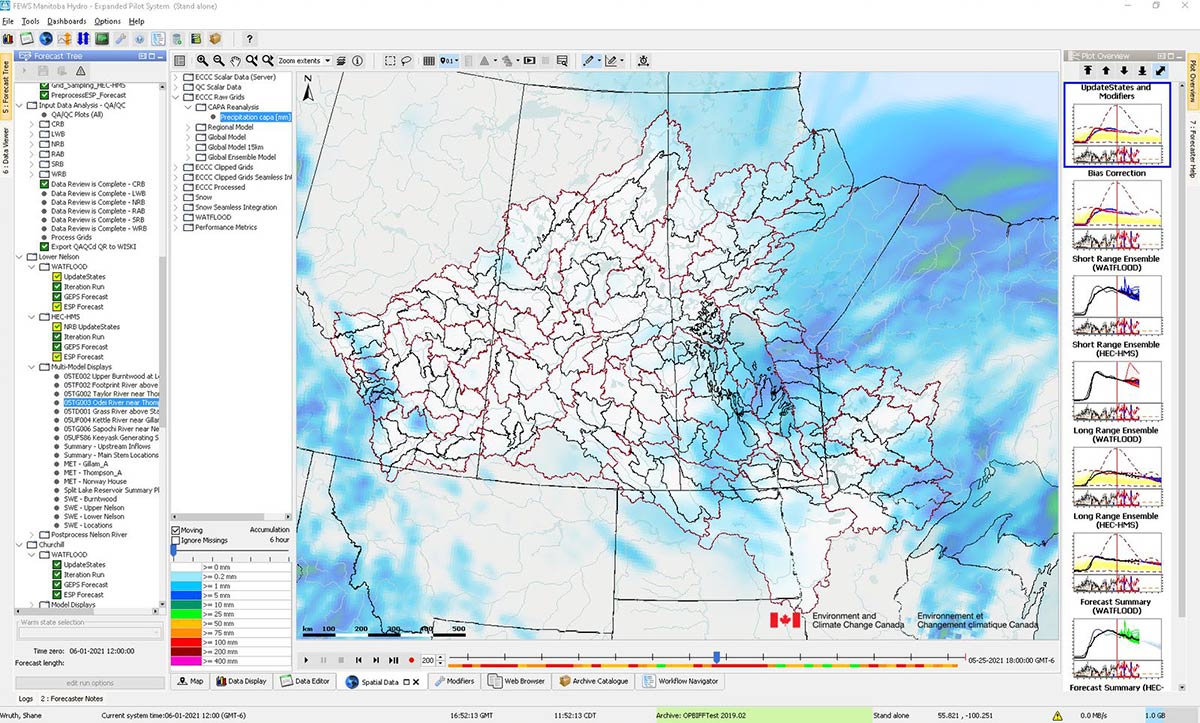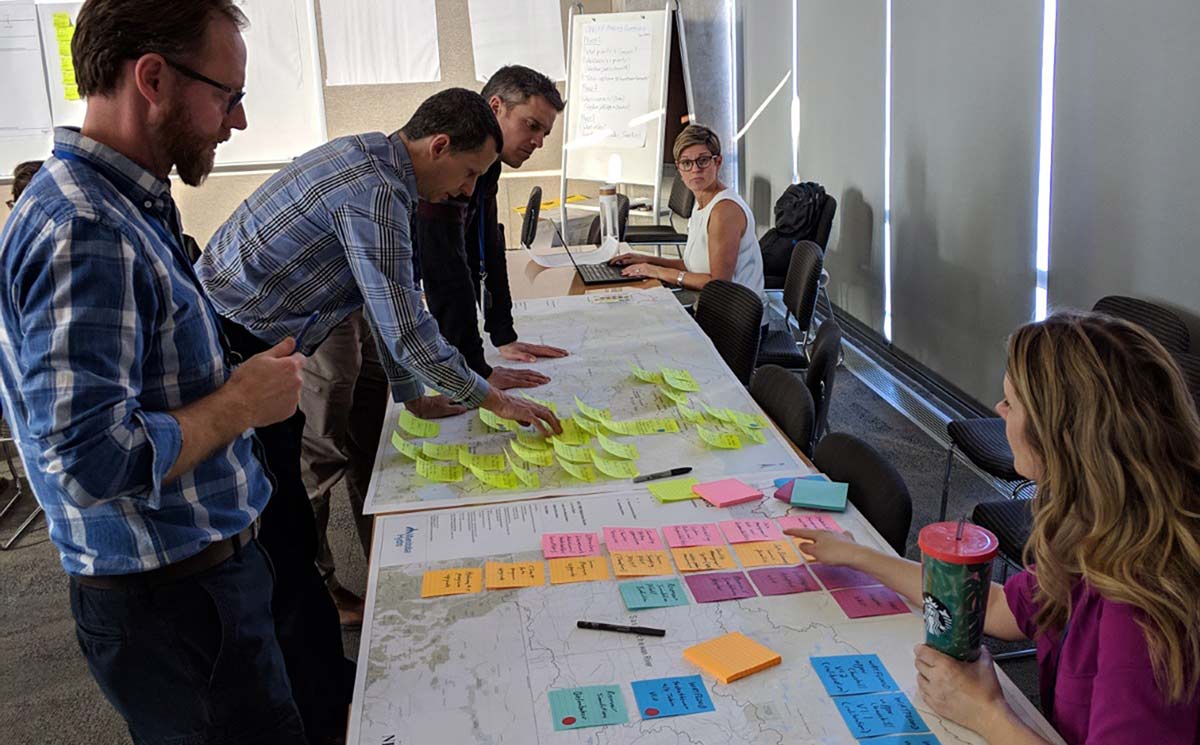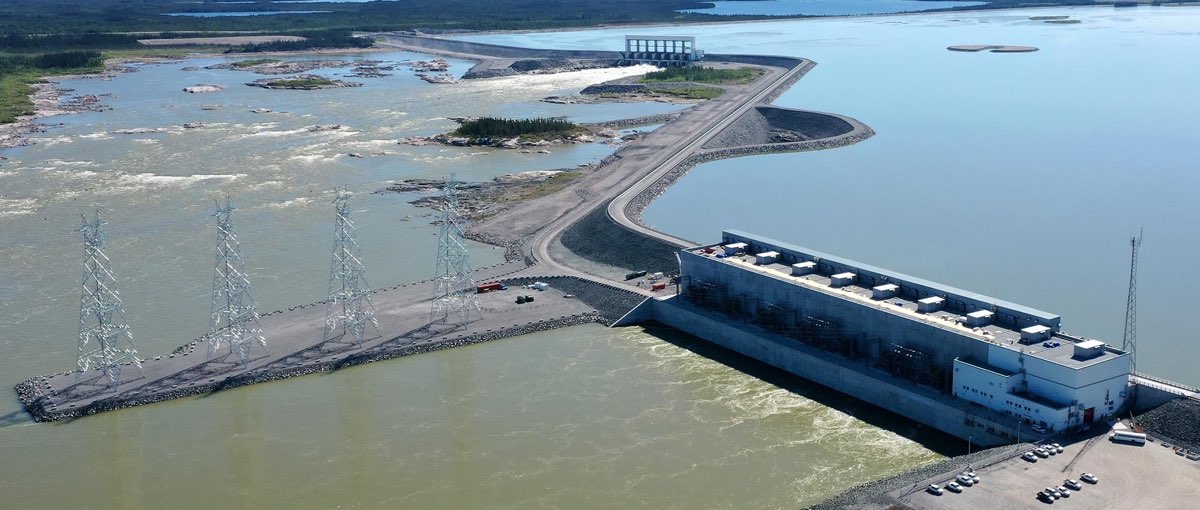Modernizing and expanding Manitoba Hydro’s water inflow forecasting
The gentle sound of rain or the sight of calm, snowy skies might make you want to cozy up under a blanket and retreat for a restful nap, but to Manitoba Hydro’s Water Resources (WRD) and Energy Supply Planning (ESP) Departments, new precipitation is always top of mind. That is because until now, it has been challenging to incorporate precipitation into the models they run to forecast how much water will enter the rivers and reservoirs we use to produce electricity. But now, that is about to change with the launch of a new and improved inflow forecasting system that transforms the way weather forecasts are used at Manitoba Hydro.
The Water Resources department works behind the scenes to provide input into some of Manitoba Hydro’s water management decisions, such as when to store water in our limited number of reservoirs, when to keep our turbines running or when to spill – decisions that can have far-reaching implications to our energy management, waterway users, and electricity revenues.
The right answer depends on a combination of factors at any given time, such as electricity demands, equipment availability, current reservoir storage levels, and export market conditions, but one of the most uncertain variables is future inflows.
This group of experts is no stranger to working with complex spreadsheets, detailed formulas, and enough data to make you dizzy to help forecast how much water from rain and snowmelt will enter the waterways our generating stations depend on to convert flowing water into electricity.
Creating these forecasts has always been a very manual and labour-intensive task. But now, our water inflow forecasting system is being modernized to create new capabilities and efficiencies thanks to collaboration between internal departments and an external technology vendor.
Moving to physically based inflow forecasting: the hydropower industry’s best practice
Historically, the planning of reservoir and generating station operations at Manitoba Hydro has been primarily based on observed flows and statistics – estimating future river flows based on current flows and trends from previous years.
This statistical forecasting method works well when reservoir levels, precipitation, snowpack, and soil moisture conditions are close to average, but can miss the mark when conditions are irregular. It is especially challenging under extreme conditions, such as floods when reservoirs are nearing capacity.
“The challenge with statistical forecasting is the limited ability to add precipitation conditions into our models, so anticipating the timing, magnitude, and impacts of inflows from rain or snowmelt runoff has been very difficult,” said Efrem Teklemariam, manager of Water Resources for Manitoba Hydro. “We needed a solution that would allow us to incorporate more data elements into our analyses to improve the accuracy of our forecasts.”
The solution? A Physically-Based Inflow Forecasting (PBIF) system that can incorporate temperature, precipitation, and weather forecast data, and simulate physical processes, such as snowmelt, infiltration, evaporation, and runoff. Coupling PBIF with Manitoba Hydro’s existing reservoir operations processes allows us to better anticipate system inflows under various weather conditions. Equipped with more accurate and quantitative forecasts, we can be more proactive in our operational planning and decision-making and better optimize our reservoir and hydraulic generating station operations for the benefit of our customers at home and across borders.

The new forecasting system incorporates forecasted precipitation and other weather events and provides improved understanding of what Manitoba Hydro can expect in the days and weeks ahead.
Using physically-based models is a well-established method and considered best practice in the hydroelectric utility industry. It’s not brand new to Manitoba Hydro – it has been used on an ad hoc basis in the planning of new projects and climate change studies for some time, but required integration with a framework software to semi-automate the process for regular operational use. This new forecasting system was put in place at high-priority forecast locations this spring, and there are plans to expand to additional locations over the next five years as part of a phased roll-out.
“Being able to better anticipate snowmelt runoff volumes and our river basin’s response to a forecast rain event means we can be more proactive in our reservoir operations. Put simply, our water management decisions will be based on better inputs,” said Kevin Gawne, Manitoba Hydro’s manager of Energy Supply Planning.
Solution will create efficiencies and new ways to share information
Aside from producing more accurate forecasts, the new system will also create efficiencies that will make internal forecasting easier and allow for greater integration with operations to streamline info-sharing within the utility.
“This new software automates a lot of routine processes, such as pulling and processing data, running models, and linking models together.
“This means our engineers will spend less time fiddling with spreadsheets and manual work, and more time on value-added activities. The system is also fully integrated with operations, so system operators have easy access to forecasts and condition reports in real-time,” said Teklemariam.
This forecasting system is a practical example of how technology and technological integration creates efficiencies in the work Manitoba Hydro does, helping us serve all our customers better through the streamlined sharing of information. Combined with self-service analytics that provide visualizations to efficiently communicate complex and detailed forecast data, projects like these to modernize Manitoba Hydro’s core operations lead to better decisions for all stakeholders – including our wholesale customers.

Manitoba Hydro project team members and forecast users collaborated early on in the planning phases to ensure the project’s success. Pictured left to right: Scott Herbert, Chris Magura, Jason Westmacott, Tammy Oze, and Kristina Koenig.
Benefits of improved forecasts reach beyond Manitoba Hydro
Our operations affect flows and water levels on many of Manitoba’s major rivers and large lakes. The utility is responsible for managing river flows in a safe and responsible manner, keeping nearby communities and waterway users in mind. The new PBIF system will provide more and higher quality models and forecasts, which will give station operators and staff more lead time to take preventive measures at our dams and alert local residents and waterway users sooner to anticipated changes in water levels or any risk of flooding.
“The more notice we can give and the more accurate we can be, the more trust we build with communities and individuals who live or recreate on these waters,” said Wes Penner, Manitoba Hydro’s manager of Waterways Approvals & Monitoring. “These relationships and this trust are prerequisites to effective communication about operational decisions.”
Aside from closely engaging property owners and waterway users on a regular basis, reports are distributed to a number of communities in proximity to our generating stations and external groups to help inform their own contingency planning.
With PBIF, Manitoba Hydro can supply more up-to-date, reliable forecasts and condition reports to internal and external stakeholders who depend on it, leading to a safer and more productive relationship between Manitoba Hydro and all its customers.
